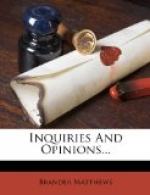Yes; when the ways oppose—
When the hard means rebel,
Fairer the work outgrows,—
More potent far the spell.
Not only has a useful addition to the accepted devices of the craft been the guerdon of a victorious grapple with a difficulty, but the successful effort to solve a purely technical problem has often led to an ennobling enlargement of the original suggestion, with which the artist might have rested content if he had not been forced to the struggle. From the history of sculpture and of architecture here in the United States during the last years of the nineteenth century, it is easy to select two instances of this enrichment of the fundamental idea, as the direct consequence of an unexpected obstacle which the artist refused to consider a stumbling-block, preferring to make it a stepping-stone to a loftier achievement.
When the city of New York was making ready to welcome the men of the navy on their return from Manila and Santiago, the Architectural League offered to design a triumphal arch. The site assigned, in front of Madison Square, just where Broadway slants across Fifth Avenue, forced the architect to face a difficulty seemingly unsurmountable. The line of march was to be along Fifth Avenue, and, therefore, the stately monument was set astride that street. But the line of approach, for most of the multitude certain to come to gaze on the temporary addition to civic beauty, was along Broadway; and the arch built squarely across the avenue would seem askew to all who first caught sight of it from the other street. To avoid this unfortunate effect the designer devised a colonnade, extending north and south, up and down the avenue. Thus he corrected the apparent slant by emphasizing the fact that it was the avenue in which the arch was placed and not the more popular highway that chanced to cut across it. But this colonnade, invented solely to solve a difficulty, lent itself readily to rich adornment. It became at once an integral element of the architectural scheme, to which it gave breadth as well as variety. It was accepted instantly as a welcome modification of the tradition,—as an amplification not to be wantonly disregarded by any architect hereafter called upon to design a triumphal arch.




